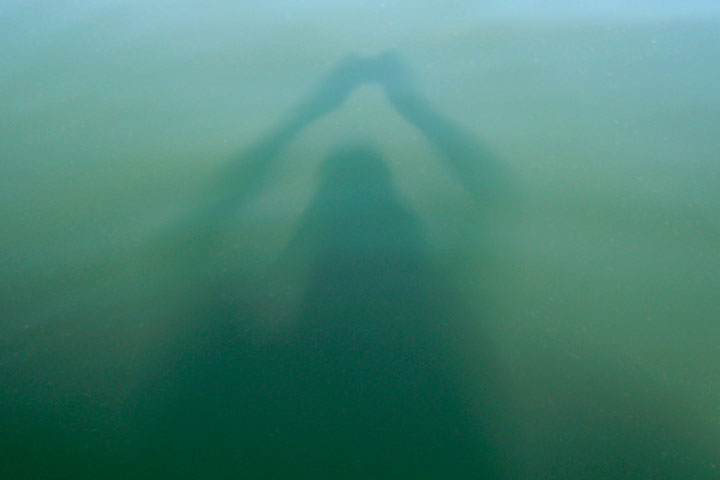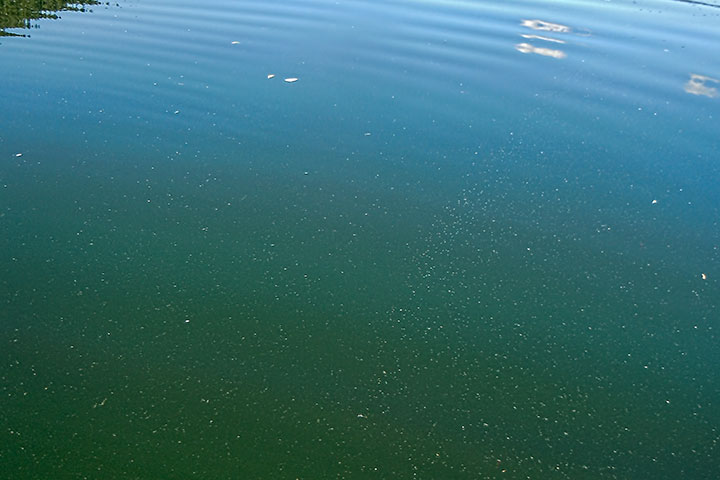The waters were drumly. Ok, you won’t find the word, drumly, in most dictionaries. It is an old Scots word meaning turbid or murky. Drumly is not how one would normally describe Kootenay Lake—a remarkably transparent, indeed potable, body of water. Yet, biological debris does settle on the Lake, and now and then it becomes locally concentrated.
I encountered such a concentration when kayaking yesterday morning. This enabled one uncommon sighting (well, uncommon around here), and one distinctly rare sighting (apparently, for anywhere).
First, a bit of background on why debris will sometimes collect in a small area.
The West Arm of Kootenay Lake is composed of a series of lakelets—wide regions separated by narrows constricted by the deltas of creeks. These lakelets are rather like pearls on a necklace; when you are in one, you have your own little lake, but a passage connects you to another pearl.
The main flow of the water through any lakelet generally follows a fairly narrow channel. Elsewhere on the lakelet there may be a backflow. Certainly, that is the case on my lakelet where the channel and the backflow forms a large gyre. Now, a gyre is an area of convergence: water drifts towards the centre and sinks. In the absence of wind and waves, all manner of debris—pollen, leaves, bugs, driftwood, lost water skis, escaped boats—collects in the centre of the gyre.
Yesterday morning, I noticed a region of my lakelet where biota seemed to be collecting, so I kayaked away from the pristine waters and into its midst.  Normally when one’s shadow is cast onto clear water, it is barely visible. But, in drumly water, the shadow becomes obvious. Further, the shadow is three dimensional and looks as if it sweeps down into the depths. For this picture, I held a camera over my head. This is an uncommon view for the Lake as the waters are normally clear. Such a view is, alas, normal for people of many other places.
Normally when one’s shadow is cast onto clear water, it is barely visible. But, in drumly water, the shadow becomes obvious. Further, the shadow is three dimensional and looks as if it sweeps down into the depths. For this picture, I held a camera over my head. This is an uncommon view for the Lake as the waters are normally clear. Such a view is, alas, normal for people of many other places.
Now for the truly unusual: a rainbow formed by the bodies of tiny insects floating on the surface of the water. A likely insect, Peter Wood tells me, is the clear larva of a midge. Truth be told, a rainbow formed by a millimeter’s depth of this biota does not produce as striking a pattern as does a kilometre’s worth of raindrops. Nevertheless, a rainbow it is.
I had heard about the phenomenon of multitudinous transparent insect bodies producing a rainbow. I had even seen a picture of it taken elsewhere. Before this morning, I had not seen such a thing myself.
Alas, my picture is not nearly as good as the one of my memory, yet, the bow across the water is evident. It is the bright band sloping diagonally from the centre bottom to the upper right. To its left is a darker region; in the argot of rainbows, this is Alexander’s dark band. To the left of the Alexander’s band is another bright region: the secondary bow. Is this bow formed by midge larvae? At this stage, we just don’t know. I went out again this morning. I could still find the drumly water, but whatever had caused the bow had come and gone.

Cool, Alistair! I’ve always thought of insects as treasures, but now it seems they may prove to be the gold at the end of their own rainbows.